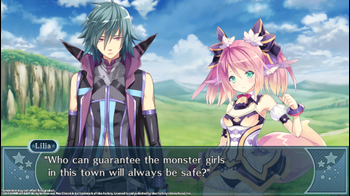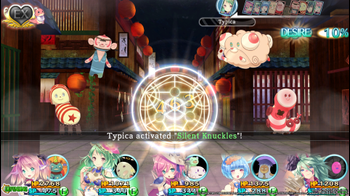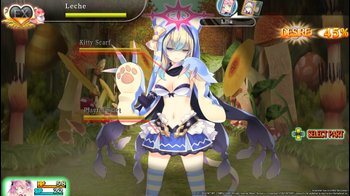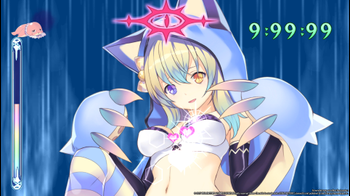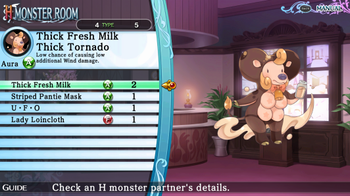
Moero Chronicle Review
My only experience with the Genkai Tokki series, of which this game, Moero Chronicle, is the second entry, was Monster Monpiece, its predecessor, and a few minutes of Genkai Tokki: Seven Pirates, which was never localized.
Like the rest of the series, it’s certainly a game that embraces its brazenness conductive of the perverted Japanese culture. But in the case of Monster Monpiece, I found a rather addictive card-based battle game worthy of my time, of which I spent more of when it came out on Steam.
This was important because it added back in the cards that were originally cut due to their content. While I’m not one to really care too much about the risque, it did have an impact on the player’s deck since you were missing some pretty good cards.
Fortunately, Moero Chronicle doesn’t have to bother with anxious console manufacturers because it has arrived in the west exclusively on Steam. And considering Valve has been far more open to more adult content, the game is free to flaunt everything it has without fear of a rating board.
First, let’s talk a little bit about the story. Io, the game's main character, has himself a little bit of a problem: the guy can’t stop thinking about lewd things any chance he gets. Because of that, he is considered a bit of an outcast from the rest of society for the way he behaves.
He also has that oh-so-appealing stereotype of being the anti-hero, but not the cool kind - he’s simply too lazy to want to do anything aside from looking after himself. Anyway, as a means to get rid of the annoying bastard, the townspeople decide he will be the next chosen one who will head out to save the world (aka the thing he hates).
Soon after he discovers the ulterior motive, he runs into his childhood friend Lilia who is, in fact, a monster girl. You see, for the longest time, humans and monster girls used to live in harmony until one day, they simply didn’t anymore.
Now they attack any humans they come across. No one knows why, so it’s Io’s job to investigate. Sounds simple, right? But while the plot could have gone in some interesting directions, it’s quickly forgotten about due to all that gosh-darn fanservice. I’m not mocking the game for that, because that’s exactly what it serves up in spades. Just know you’ll have a difficult time following the narrative since that fanservice is all up in your face.
Let me get this out of the way first - Io is the absolute epitome of a useless male protagonist. When I first caught sight of him back when Compile Heart was originally marketing the game for Japan, I made the wisecrack that Moero Chronicle “has a main character who dressed himself because he's a big boy, oh yes he is.”
It’s almost cringeworthy how dull all his characteristics are. He’s like an amalgamation of the anime protagonists I never cared for. You know, the one you always have to ask, “What does everybody else see in this guy where he gets all the women?” I feel like I start to lose brain power just seeing him on screen and have to repress the need to try and punch him through my screen. And he has a very punchable face.
Sure, no one is coming to these games for the dudes, but he doesn’t make the adventure that much more interesting. And because he loves to whine all the time, he immediately gets on your nerves with his attitude.
While other RPGs may take this as a way to provide character development over the course of the story, by the time I was done, I was just happy Io was in the rearview mirror (after I ran him over a few times). A silent protagonist would have done this game wonders.
Let’s talk about something else so I don’t have to feel aggravated. Anyone who has played a Compile Heart lately will be used to the design esthetic the developer typically employs. Everything is all bright and colorful with plenty of emphasis on its animated characters and slightly oversized menu navigation.
Character designs are equally eye-catching - in many respects. While Moero Chronicle peers over into the abyss that is full-on eroge, it stops just short of doing so. Sure, you’ll see plenty of scantily clad people throughout the game, it never gets to the point of nudity.
For what it’s worth, there was just enough variety in the art itself to keep me looking forward to the next person I met and the costumes they had on. And as long as you’re comfortable with the type of content going on (or it doesn’t phase you), you may appreciate these aspects - even if many of the characters embody identifiable anime tropes.
The gameplay itself resembles a dungeon crawler with visuals like Etrian Odyssey or Demon Gaze. You navigate around 3D maps with a first-person perspective, making one step at a time as you fill out the mini map. Each area has treasure chests, material spots, and other places to get items.
There’s even a decent amount of puzzles to solve, though many are simply switches which require some backtracking. Nothing too complicated there, though you better be prepared for the random encounters, and they happen frequently. There’s no way to tell if you’re about to hit one like in some other games of this genre.
The problem is, though this is a dungeon crawler, you can only save at certain save spots that tend to be on every other floor of the labyrinth. While that means you won’t be able to save scum to success, it would have been nice to avoid this entirely.
It makes me wonder whether this would’ve been actually enjoyable on a PlayStation Vita where you may run out of battery between saves. I actually had some real trouble starting off because you begin with only a single party member.
Moero Chronicle’s combat follows this same gameplay design. Enemies appear in front of you and your party of monster girls is displayed at the bottom of the screen. Only, this game takes it in a more… pervy direction.
You “store” your desire, which gradually increases as a percentage over time, and then “release” your desire to power up the next action of each monster girl. If you have too much desire, you will explode (been there). This puts you in “calm time,” or a cooldown period which removes all of your desire and causes you to lose a turn.
In order to coax out your desire, each of your party members can “charm” you to increase the desire meter's percentage significantly while decreasing calm time. While this all sounds a little complicated, these are all basic commands I was quickly able to get used to. The only downside here is your Desire gauge doesn’t carry over between battles.
Another important mechanic is the way weaknesses work. There are four kinds of elements at play here: fire, wind, earth, and water. By paying attention to the aura of the enemy that matches the colors of these elements, you can figure out what’s stronger than the other.
Since it works in a circle, it goes Fire > Wind > Earth > Water > Fire. Of course, this assumes you have a party member who is imbued with the stronger element, but it’s a key feature here.
If you continue to attack their weak point, an Auro Combo occurs, which increases the number of experience points and the chances of getting items from the encounter. It’s a neat but simplistic system that encourages player strategy.
There also comes a time when you’re able to recruit other monster girls into your party. How does this happen, you ask? Why, by maxing out their excitement gauge, of course! You do this by attacking them or destroying the clothes off their bodies.
You can even specifically target the parts of their costume, which elicits a sharp moan from the girls. Suffice to say, I had to play with the volume set to low so I wouldn’t bother my roommates.
This carries over to when you send your “positive desire” to the monster girls, or how mascot character Otton puts it, “shoot your outpouring passion at her.” I couldn’t help but laugh when I read that line.
This is all done through the bumping scratch mode, which helps the monster girls regain their senses after being hypnotized by this evil curse. Like Monster Monpiece, you perform this by touching, poking, and rubbing the different weak points on the girl.
In my case, I was using a PS4 controller, so it was mapped to the face buttons and the analog sticks. But you don’t want to rub too hard. The tutorial puts it best: “Monster girls are very sensitive. Touch them gently.”
If you do a good enough job, the Nude Flash opportunity will be activated which will greatly increase the Purify gauge that helps you win over the monster girl. This is a time-limited feature, so you have to rub as hard as you can until it ends. Reaching max excitement level activates the bumping scratch. If you don’t do all of this time, the monster girl may escape and you won’t have another encounter with them for some time.
There’s a problem worth pointing out with this combat system. You see, when your round begins, Io is the first one to act, followed by the rest of the turn order (which depends on their speed stat, like in other RPGs). The issue is, Io is the only person who can use items. While your party is able to use skills to heal each other, they're not able to restore their SP, or skill points - sort of like MP. And if you accidentally button mash through Io's turn, you can't go back to re-choose the action he takes. So if you're low on HP and SP, you can potentially screw yourself into a game over.
Yeah, this can be frustrating. You’re not even given any starting items for your journey. Everything comes at a price, which makes the game that much more challenging. At least you recover your HP and SP when you level up or hit a save spot, and you recruit your first full group of party members fairly quickly.
My other real nitpick of this is whenever you go to store your desire, Io yells, “Ahhhhhhhh!” like he’s charging up. Having this happen every round really started to get on my nerves early on, and he sometimes goes really over the top with it. So you can imagine how I was feeling after putting up with this for several hours.
Things get more interesting once you head back into town. After visiting the Inn by reaching a certain point early in the game, you unlock the ability to rank up the rooms each monster girl sleeps in. This is done by using building materials and G, which is the game’s currency.
By ranking up a room, you can grant different bonuses like providing them a percentage of experience points even if the monster girl wasn’t a part of the adventure. Plus, not only does this have an impact on your intimacy, but it also changes the background art to represent the upgrade - a neat effect. Materials can be found out in the field or as rewards for giving out presents.
These rooms offer different opportunities you can take advantage of. As mentioned, you’ll be able to chat with each monster girl, offer them a present, and do the bumping scratch with them, which raises their intimacy meter.
As you can imagine, intimacy plays a key role in the game. As you raise your affection levels with one of the monster girls, this unlocks new events. It’s yet another layer of fanservice the game provides to players and is one that has appeared in other Compile Heart games.
There’s even the Egg System, which lets you produce items from the panties you collect from dungeons. The higher grade panties you pick up, the better the items you get. While it sounds a little bizarre typing that out, it’s essentially a crafting system that’s fairly straightforward.
And while it’s nice that it adds additional content to the game, a lot of it feels a tad overwhelming. You’ll be so involved with traversing the dungeons that having to go back to town to individually go through each monster girl’s room (of which there are many of them) is some real busy work.
But if that doesn’t bother you so much, it can be a nice way to unwind. It helps each monster girl has something to say when you come back, so if there’s a particular character you like, you can have a full discussion with them - even if they don’t always have something interesting to say.
An interesting feature is the H monsters. Throughout the game, after each enemy encounter, you have the chance of recruiting one of the monsters you fight. They head back to the inn where you can perform a Pet Pact, which makes them pets of the monster girls. Each of these H monsters has different skills that can support the one they’re with.
There is no English voice option to speak of. Instead, if you try to change the language under the settings, it will change all of the text in the game. You can imagine how big a mistake this was trying to navigate my way back after accidentally choosing Chinese (luckily, it was only a few click).
Speaking of settings, there isn’t a lot of room for configuration on PC. You are able to remap your keyboard or controller; mess with the audio mixing; change the resolution; and decide between fullscreen, windowed, and borderless window modes. I encountered some glitches with trying to set borderless mode and getting full-screen instead, but I’ll chalk it up to the early beta I was playing.
Don’t expect an opportunity to play with the anti-aliasing or draw distance. Granted, this was originally a PlayStation Vita game, so adjust your expectations accordingly. It’s not really the type of game that benefits from a ton of graphical features; with Compile Heart, you accept they have a particular design philosophy and they’ll stick to it.
By its very nature, Moero Chronicle is a difficult game to recommend. When you’re trying to convince someone to give it a try, it will always come with a number of warnings ahead of time. I mentioned earlier how this straddles the line between your typical anime-heavy dungeon crawler and eroge.
It’s not a particularly memorable game, either. Outside of its obvious attempts to pull in a certain audience, nothing about it genuinely stands out, which is a shame. As someone who is typically into Compile Heart’s games and can find something to latch onto, whether it’s the writing, the music, or the characters, this lackadaisical effort stands firmly in the average category.
So if you are the kind of anime fan who doesn’t mind the inclusion of A LOT of fanservice, Moero Chronicle may just be the game for you. For everyone else, it’s a serviceable title that feels pretty basic in design with some funny moments, but tries a little too hard to pull in a particular audience. Just be aware it may take you awhile to get over having Io in your party.
